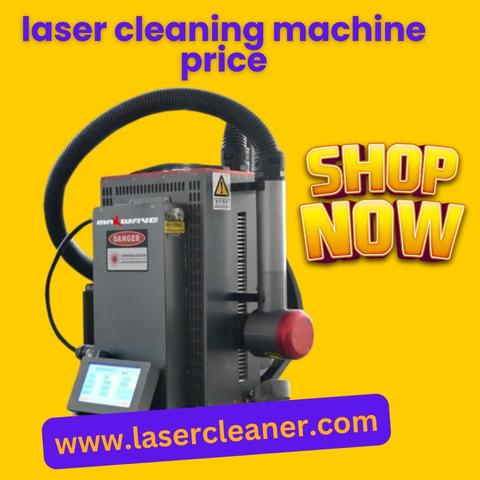Why do laser cleaning machine price ranges vary so drastically from one supplier to another?

When it comes to investing in a laser cleaning machine, one of the most commonly asked — and often misunderstood — concerns is the laser cleaning machine price. A quick online search might show you prices starting from a few thousand dollars to upwards of $80,000 or more. Such a wide range can confuse even experienced industrial buyers. Why does the cost swing so wildly? What are you really paying for, and where is the line between cost-efficiency and quality compromise?
In this detailed guide, we’ll unpack the elements that shape the pricing of laser cleaning machines and explain what influences the figures vendors quote. If you're planning a purchase, this guide will help you understand what’s behind the number and how to make sense of it.
Understanding the Basics Behind the Price
The laser cleaning machine price is not determined by a single factor. It's the result of a mix of variables including power capacity, laser source origin, application scope, control systems, cooling mechanisms, automation compatibility, and after-sale services. Each of these components contributes to the machine’s final cost — either directly or indirectly.
When asking why prices vary so much, consider this: no two businesses have exactly the same cleaning requirements. One company might need a low-wattage portable device for mold removal, while another might need a high-power machine for cleaning rusted pipelines on an oil rig. Both are laser cleaners — but built for completely different demands. That gap in use case creates a huge gap in pricing.
Power Output and Cleaning Scope
The first and often most obvious factor in determining the laser cleaning machine price is its power rating — typically measured in watts. Machines are commonly available in 50W, 100W, 200W, 500W, and even up to 3000W models. But it’s not just a numbers game.
Higher wattage machines are built with heavier-duty components, require better cooling systems, and are meant for continuous industrial operations. The components inside a 2000W cleaner are significantly more robust and expensive than those in a 100W desktop unit.
A 100W entry-level cleaner might be priced around $5,000–$10,000. Meanwhile, a 1000W high-performance system suitable for aerospace or shipyard applications can go beyond $60,000. It's not only about raw cleaning power — it’s about the duration, intensity, and application precision that comes with higher wattage.
Origin of Laser Source
Another major price influencer is the origin of the laser source itself — the heart of the machine.
Fiber lasers are the most common in laser cleaning machines, and they're produced by several manufacturers globally. IPG (Germany), Raycus (China), MAX (China), and JPT (China) are well-known names in the market.
Machines using German IPG laser sources usually command a premium. This is due to the long operational lifespan, reputation for reliability, and consistent beam quality. A machine using an IPG laser source can cost $10,000–$20,000 more than one using a local Chinese brand. That doesn’t mean one is better for everyone — it depends on your cleaning needs, but it does play a significant role in shaping the laser cleaning machine price.
Portability and Design Complexity
Laser cleaning systems come in various formats — handheld, robotic, mobile cart-based, or integrated in production lines. Each type brings a different engineering challenge.
Handheld portable machines require lightweight yet durable enclosures, ergonomic design, and internal power management. These units are typically in the range of $7,000–$15,000 for basic models. On the other hand, robotic-integrated systems involve CNC programming, automation hardware, and positioning sensors — and their prices reflect that complexity.
A machine designed for precision cleaning of turbine blades or circuit boards will include far more sophisticated control mechanisms and beam delivery systems than a general-purpose cleaner. That specificity increases development and manufacturing costs — all reflected in the final price.
Cooling System Type
Laser cleaning produces heat — and that heat must be managed. Machines come with either air cooling or water cooling systems. Lower wattage machines typically rely on air cooling, which is simpler and cheaper. As wattage increases, heat becomes a serious concern, and water cooling becomes necessary.
Water-cooled machines use chillers, pumps, radiators, and electronic controllers — adding hundreds or even thousands of dollars to the build. So, a 1000W machine with a reliable industrial chiller setup will always carry a higher price tag than an air-cooled 200W version.
Control Software and Interface
Software might not be the first thing that comes to mind when considering laser cleaning machine price, but it plays a crucial role in both functionality and cost. Some machines come with basic touch screens and fixed settings, while others are programmable, integrate with factory systems, and support multi-language menus.
A machine with proprietary control software, real-time monitoring, error logging, and adaptive cleaning modes will be priced higher than a unit with simple up/down power toggles. These added software capabilities improve accuracy and repeatability in industrial settings — something that might be mission-critical for a manufacturing company.
Import Taxes and Compliance
Your location significantly affects the laser cleaning machine price due to taxes, shipping costs, and regulatory compliance. Machines imported into the U.S., Europe, or Canada may be subject to additional customs fees and require safety certifications (like CE or FDA approval). These compliance standards increase manufacturing cost and may also increase the distributor’s margin.
On the other hand, a local or regional supplier may offer better post-sales support, lower import taxes, and quicker delivery — but might come at a higher upfront price due to limited manufacturing scale.
After-Sales Support and Warranty
While not immediately visible in the purchase invoice, after-sales support is indirectly embedded in the price. Machines that come with international warranties, service agreements, technician support, and training packages usually cost more. But they also save costs in the long run by reducing downtime and ensuring longer equipment lifespan.
Some suppliers offer 12-month warranty with limited support, while others provide 2–3 year full support with on-site servicing and replacement coverage. The level of this support affects the price — and should be carefully evaluated when comparing quotations.
Brand Recognition and Reputation
Lastly, the laser cleaning machine price is also impacted by the manufacturer’s brand. Just as consumers pay more for a premium smartphone or luxury car, industrial buyers often pay more for trusted brands that have proven track records and client portfolios. This branding factor isn't about materials or components — it's about perceived reliability and market trust.
Final Thoughts
Laser cleaning is not a one-size-fits-all technology. The laser cleaning machine price you encounter reflects not just the physical components, but also the machine’s build quality, long-term durability, customization level, and support structure. While it may be tempting to focus purely on price, it’s essential to match your investment with your application needs and production goals.
Before making a decision, identify the cleaning challenges in your operation, calculate long-term operational costs, and ask vendors for detailed quotes including training, warranty, and logistics. Only then will you be able to assess if a machine offers genuine value — and whether its price aligns with your business expectations.






